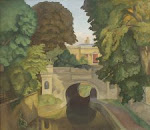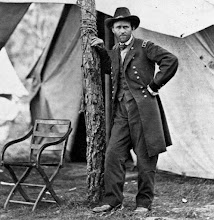Dear readers, you have heard me say this before (and you will no doubt hear me say it in the future): Life is far simpler than we make it out to be. It is nothing more (and nothing less) than an all-too-brief gambol in the sun. Edward Thomas is exactly right:
No day of any month but I have said --
Or, if I could live long enough, should say --
"There's nothing like the sun that shines today."
There's nothing like the sun till we are dead.
These lines bring to an end a twenty-line poem, and, as is so often the case with Thomas, his conclusion contains a qualification: "Or, if I could live long enough, should say . . ." ("
The poetry of almost infinitely-qualified states of mind," as Philip Larkin so perfectly puts it. The influence of Robert Frost's equivocal, self-reversing poetic conclusions on Thomas cannot be discounted either. Or did Thomas influence Frost? Kindred spirits, in any case.) The qualification is wholly understandable: Thomas wrote the poem in November of 1915 at Hare Hall Camp, Essex, where he was serving as a map-reading instructor. Still, the overall tone is one of joy and celebration, as it should be when one speaks of the sun.
De Sole
after Ficino
If once a year
the house of the dead
stood open
and those dwelling
under its roof
were shown the world's
great wonders, all
would marvel beyond every other thing at
the sun
Charles Tomlinson,
The Shaft (Oxford University Press 1978).
I presume that the poem is Tomlinson's version of a prose passage from
Liber de Sole ("The Book of the Sun") (1493)
by Marsilio Ficino (1433-1499).
William David Birch (1895-1968)
"Morning in June, the Vale of Dedham, Essex"
"
The colossal sun,/Surrounded by its choral rings": it is not a thing to be stared at. Instead, we come to know our star through its revelations, emanations, and creations. I am
not speaking of scientific knowledge.
One recent warm afternoon, an afternoon on which, as we are wont to say, "there was not a cloud in the sky," I heard bird conversations coming from high overhead as I walked beside a large meadow. There were no trees nearby. The chirping and chattering and twittering came from out of the empty air of the blue-interwoven-with-gold sky. But, of course, the air was not empty. The swallows were going about their afternoon feeding, curving and sweeping and diving just above the dry grass and the pink-purple sweet peas of the meadow, then disappearing into the overarching brightness.
Solar Creation
The sun, of whose terrain we creatures are,
Is the director of all human love,
Unit of time, and circle round the earth
And we are the commotion born of love
And slanted rays of that illustrious star
Peregrine of the crowded fields of birth,
The crowded lanes, the market and the tower
Like sight in pictures, real at remove,
Such is our motion on dimensional earth.
Down by the river, where the ragged are,
Continuous the cries and noise of birth,
While to the muddy edge dark fishes move
And over all, like death, or sloping hill,
Is nature, which is larger and more still.
Charles Madge,
The Disappearing Castle (Faber and Faber 1937).
Bertram Priestman, "The Sun-Veiled Hills of Wharfedale" (1917)
The manner in which unsolicited and unwanted human-created images insinuate themselves into our mind, heart, and soul can be alarming. At this point in my short remaining time above ground, I have decided that poems, paintings, and other works of art are welcome, subject to my arbitrary standards of admission (Beauty and Truth), which are applied in an unsystematic and idiosyncratic fashion. On the other hand, images and messages from the political, entertainment, and media worlds are not welcome, and are avoided as much as possible. "News" is forbidden.
But, of course, it is the real World that matters, not merely images of that World, however beautiful and true they may be. What I have in mind, for instance, is the large, blooming lavender bush that I recently passed while walking through the neighborhood on a hot, sunny afternoon. The bush was covered with dozens of bumblebees, hovering at the constellated flowers, abuzz. "
Makings of the sun." The beginning and the end.
Solar
Suspended lion face
Spilling at the centre
Of an unfurnished sky
How still you stand,
And how unaided
Single stalkless flower
You pour unrecompensed.
The eye sees you
Simplified by distance
Into an origin,
Your petalled head of flames
Continuously exploding.
Heat is the echo of your
Gold.
Coined there among
Lonely horizontals
You exist openly.
Our needs hourly
Climb and return like angels.
Unclosing like a hand,
You give for ever.
Philip Larkin,
High Windows (Faber and Faber 1974).
Stanley Roy Badmin (1906-1989), "Stormy Evening, Glencoe"












